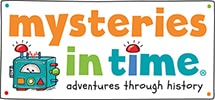These top tips for teaching history will bring history to life!
If you are looking for some top tips for teaching history, you’ve come to the right place! Long gone are the days when facts were chanted over and over in a group. History is not just dates on a page. History is basically a rich tapestry of human stories and human lives over the centuries. Even the word ‘history’ has the word ‘story’ in it. History is an exciting subject area and one of the most fun subjects to teach. The important thing about making history memorable for history teachers is to make it interactive and fun. There are many ways you can do this. Here are some simple ideas to get you started!
1. Historical Fiction and Fact Books
Use a range of books on the topic – mix up historical fiction and non-fiction. Start by reading a fun fictional story about the era that will captivate their imagination. It’s a great way to set the scene! It’s easier to imagine a place when characters are living it. Mix in some colourful non-fiction books to explain what they have learnt. Make sure all history factual books you use are colourful and written in child-friendly language. If it’s boring to look at, it won’t keep their attention!
2. Fun
Use fun word games along the way like word searches or crosswords to cement the learning. The key here is repetition. Keep using the same words and ideas you’ve been learning about to make a puzzle or a fun quiz. The more they use the terms, both in and out of context, the more they will remember them. And the more fun the activity is, the more excited they will be to learn!
3. Props
Bring in props to help bring the history to life. It doesn’t have to be expensive real-life artefacts; it could be a photograph of an object, or you could all have a go at making a relevant item out of air-drying clay. Once dry, you have your artefact!
4. Costumes
Dress up in costumes from the historical era. Wrap a sheet around you like an Ancient Greek toga, or make an Ancient Egyptian pharaoh’s headdress. However you do it, it is immersing kids in the history and helping them visualise the era. They will remember the learning as a result!
5. Timeline
Print off a large timeline that covers from Ancient Times to the modern day. Add a label for each era – you can either mark the start or end of each era, or place it in the middle. As long as you are consistent, it doesn’t matter! An even better idea is to cut out a strip of paper to show how long the era lasted. Or add a pin to the start and finish and pull a piece of string between the two. As you continue to explore new times in history, it will build up a visual understanding of how historical eras fit together.
6. Field Trip
Go on a field trip. Visit museums, castles, old houses, folk villages or national parks. History is all around us, so look to your local area for learning opportunities. Point out features of a Victorian house as you walk through your local area or find a public clock that uses Roman numerals. History can be found everywhere! Check out this great online resource with the British Museum.
7. Cross-curricular
Through your history lessons, make the learning cross-curricular. Learn a bit about the modern-day country that you’re studying for Geography. Make some Art that brings the history to life. Practise Literacy by writing a story or a diary entry as if you were there. Make a non-fiction mini booklet with contents and a glossary. For some Drama, put on a play and act out an historical event. Just some fun ideas to bring all the learning together!


